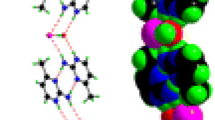Abstract
Dehydrogenation of a 5,6-dihydro-acridine with palladium on carbon led to partial dehydrochlorination and formation of a mixture of two indolacridines C26H17ClN2 and C26H18N2 which are only distinguished by substitution of a chlorine by hydrogen atom. They co-crystallize from ethanol as a solid solution of the two compounds with ratios between 90:10 and 42:58 by whole molecule disorder in a triclinic \(P \bar {1}\) setting. Unit cell dimensions for a crystal with a 0.615(2) to 0.305(2) ratio are a = 9.1952(16), b = 10.2589(18), and c = 10.6268(19) Å, and α = 79.688(3), β = 67.156(3), and γ = 86.897(3)°. The replacement of chlorine by the smaller hydrogen causes all atoms of both molecules to be shifted against each other within the unit cell by 0.3–0.4 Å. The structure is thus a rarely reported example of a true solid solution of two chemically distinct organic compounds. Weak packing forces (C–H···Cl, C–H···π and π···π stacking interactions) give the structure enough flexibility to accommodate the co-crystallization of the two spatially different molecules.
Graphical Abstract
Two indolacridines C26H17ClN2 and C26H18N2 only distinguished by substitution of a chlorine by hydrogen atom co-crystallize by whole molecule disorder to form a solid solution of the two compounds. They take up the same volume within the unit cell with occupancies between 90 and 42% for the chlorinated derivative. The replacement of chlorine by the smaller hydrogen causes all atoms of both molecules to be shifted against each other within the unit cell by 0.3–0.4 Å. The structure is thus a rarely reported example of a solid solution of two chemically distinct organic compounds.




Similar content being viewed by others
References
Humphrey GR, Kuethe JT (2006) Chem Rev 106:2875. doi:10.1021/cr0505270 and references cited therein
Knolker HJ, Reddy KR (2002) Chem Rev 102:4303. doi:10.1021/cr020059j and references cited therein
Lescot E, Muzard G, Markovits J, Belleney J, Roques BP, Le Pecq JB (1986) J Med Chem 29:1731. doi:10.1021/jm00159a028 and references cited therein
Sridharan M, Rajendra Prasad KJ (2007) J Chem Res 3:164
Sridharan M, Rajendra Prasad KJ, Ngendahimana A, Zeller M (2009) J Chem Crystallogr 39(4):270–278. doi:10.1007/s10870-008-9469-9
Sowmithran D, Rajendra Prasad KJ (1986) Heterocycles 24:711. doi:10.3987/R-1986-03-0711
Rajendra Prasad KJ, Vijayalakshmi CS (1994) Indian J Chem 33B:481
SMART for WNT 2000 5.630 (1997–2002) Bruker AXS Inc, Madison (WI), USA. Bruker
SAINT + 6.45 (2003) Bruker AXS Inc, Madison (WI), USA. Bruker
Apex2 v2.1-4 (2007) Bruker AXS Inc, Madison (WI), USA Bruker
SHELXTL 6.14 (2000–2003) Bruker AXS Inc, Madison (WI), USA Bruker
Mercury CSD 2.0 (Build 4) (2007) Copyright Cambridge crystallographic data centre. CCDC
Noma Y, Muramatu T, Nishizawa K, Ohno M, Sakai SI (2002) Organohalogen Compd 56(Dioxin 2002):413
Janiak T (2008) Appl Catal A 335(1):7
Ukisu Y, Miyadera T (2001) Organohalogen Compd 54(Dioxin 2001):119
Ukisu Y, Miyadera T (2006) React Kinet Catal Lett 89(2):341. doi:10.1007/s11144-006-0146-8
Flippen-Anderson JL, Deschamps JR, Gilardi RD, George C (2001) Cryst Eng 4:131. doi:10.1016/S1463-0184(01)00002-8
Bürgi H, Blanc E, Schwarzenbach D, Liu S, Lu YJ, Kappes MM, Ibers JA (1992) Angew Chem Int Ed Engl 31(5):640. doi:10.1002/anie.199206401
Kirsop P, Storey JMD, Harrison WTA (2006) Acta Crystallogr C 62:o376. doi:10.1107/S0108270106017707
Ichharam V, Boeyens JCA (2001) Cryst Eng 4(2–3):171. doi:10.1016/S1463-0184(01)00011-9
Blockhuys F, van de Velde CML, Maes ST, Peten C, Geise HJ, van Alsenoy C, Lenstra ATH (2003) Acta Crystallogr B 59(6):770. doi:10.1107/S0108768103021013
Burchell TJ, Soldatov DV, Enright GD, Ripmeester JA (2007) Cryst Eng Comm 9:922. doi:10.1039/b708695d
Dabros M, Emery PR, Thalladi VR (2007) Angew Chem Int Ed 46:4132. doi:10.1002/anie.200604830
Lynch DE, Smith G, Byriel KA, Kennard CHL (2006) J Chem Soc Chem Commun 1992:300–301
Smolka T, Boese R, Sustmann R (1999) Struct Chem 10:429–431
AakerIy CB, Beatty AM, Helfrich BA (2001) Angew Chem Int Ed 40:3240–3242
Cheung EY, Kitchin SJ, Harris KDM, Imai Y, Tajima N, Kuroda R (2003) J Am Chem Soc 125:14658–14659
AakerIy CB, Desper J, Urbina JF (2005) Chem Commun 2005:2820–2822
Bhogala BR, Basavoju S, Nangia A (2005) Cryst Growth Des 5:1683–1686
Friščić T, Trask AV, Jones W, Motherwell WDS Angew Chem Int Ed 45:7546–7550. doi:10.1002/anie.200603235
Bürgi H, Capelli SC (2003) Helv Chim Acta 86((5):625. doi:10.1002/hlca.200390138
Acknowledgments
We would like to acknowledge UGC, New Delhi, India, for the award of Major Research Project Grant No. F. No. 31-122/2005. M. S. thanks UGC, New Delhi for the award of a research fellowship. The diffractometer was funded by NSF grant 0087210, by Ohio Board of Regents grant CAP-491, and by YSU.
Author information
Authors and Affiliations
Corresponding author
Electronic supplementary material
Below is the link to the electronic supplementary material.
Rights and permissions
About this article
Cite this article
Sridharan, M., Rajendra Prasad, K.J., Kotheimer, A.E. et al. Whole Molecule Disorder in a Solid Solution of Two Indoloacridines. J Chem Crystallogr 39, 804–811 (2009). https://doi.org/10.1007/s10870-009-9562-8
Received:
Accepted:
Published:
Issue Date:
DOI: https://doi.org/10.1007/s10870-009-9562-8




